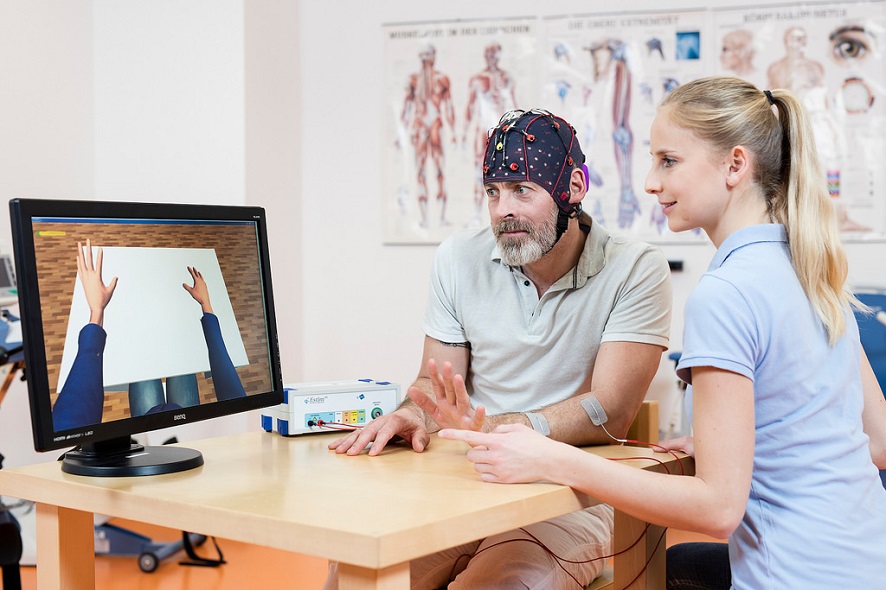At 11 AM, things get underway—people programming, inputting, designing, and 3-D printing for all they’re worth. Exactly 24 hours later, the BR41N.IO Hackathon’s 14 projects will be presented to a jury that will crown the three best in each of two categories: hacking and design. Though highly diverse, all the projects are takes on the same theme: brain-computer interfaces (BCIs). At the nexus of human and machine, devices can be controlled with the power of the mind.
The BR41N.IO Hackathon is being organized by g.tec medical engineering GmbH. The pre-registration deadline is August 27, 2017. All participants receive a free pass to the 2017 Ars Electronica Festival.
We talked to Christoph Guger, founder and CEO of g.tec, and Sarah Breinbauer, the company’s marketing and events manager, to find out more about the program and its challenges.

Sarah Breinbauer and Christoph Guger. Credit: Martin Hieslmair
The Hackathon at the Festival is all about BCIs. So, what are they and what can you do with them?
Christoph Guger: A brain-computer interface connects a human being to a machine. It measures a person’s brain waves with small electrodes applied to the head. When a person imagines something, the BCI translates these signals, which makes it possible to use them to control all sorts of machines—from robots to earthmovers. For example, a BCI can be used to write a text on a computer, which is invaluable, above all for quadriplegics. At g.tec in Schiedlberg, for instance, we employ this for rehabilitation of stroke patients. We can use BCI to teach the brain to reacquire motor skills.

Credit: Florian Voggeneder
How far advanced is this technology now?
Christoph Guger: This technology has existed for about 20 years. Three institutions were the early adopters; now several hundred are working on this technology, which is why there are already so many applications available. They’re useful above all in medical fields, for rehabilitation or diagnoses.
Basically, we differentiate between non-invasive and invasive brain interfaces. The electrodes are either applied to the outside of the head—that’s the non-invasive way—or implanted under the skull. Using this invasive method, the system is situated directly on the cortex, which produces a considerably better control signal. One or the other method is required, depending on the application. For stroke rehabilitation, it’s sufficient when the electrodes are applied to the outside of the head. This enables us to ascertain, for example, that a stroke patient is focusing on his/her right hand, whereupon the right hand can be stimulated so it can execute a movement. The result of this is that the brain re-learns motor control of the right hand. But if, for example, you want to control a humanoid avatar or a robot, then you need a much better control signal. In this case, it makes sense to implant the electrodes directly into the motor cortex. This is better for decoding thoughts and then transmitting them to the avatar.
What sort of BCI projects will Hackathon participants be working on at the Festival?
Sarah Breinbauer: At the Hackathon, you can work at the interface of human and machine. Hackers working in crews will be assigned to program a brain-computer interface in such a way that you really can use it to steer a robot, draw with a machine, or write Facebook status updates.
Christoph Guger: Among the machines they’ll be able to control are a drone and a Sphero, a robot inside a sphere. These kinds of projects are conceived for hackers—that is, people who can program. It’s helpful to know your way around Unity, maybe signal processing too, depending on which project you decide on. We also have projects for artists to design headsets for the BCI devices. For these projects, we need people who are really creative.
Sarah Breinbauer: This is also the reason why we were so inspired by artist Anouk Wipprecht, who’ll be serving as a mentor at the Hackathon. In her Agent Unicorn project, she employs a design that doesn’t look like a conventional BCI headset. It’s a sort of unicorn that records data.

“Agent Unicorn” by Anouk Wipprecht. Credit: Marije Dijkema
Before the Hackathon actually begins, Anouk Wipprecht will give a talk and explain a little about Agent Unicorn. What’s her project all about?
Christoph Guger: Agent Unicorn is a BCI headset that plays video sequences when it’s triggered by an EEG. When an autistic child is wearing an Agent Unicorn and an incident occurs, the headset recognizes that from the EEG and immediately displays a video showing the child how to react to such events. Anouk Wipprecht is making her headset’s 3-D printer data available for the Hackathon. The designers can modify the data and build something new out of them. Plus, a group from Linz Art University is coming by with six sewing machines that can be used to design headsets, which can then also be worn and used by the hackers.
You’re also lining up a special program for little kids…
Sarah Breinbauer: At the Kids’ Station, little hackers can build their own headset. Kids have a very different approach to control as well as to play, so this will definitely be interesting.
Christoph Guger: This will involve the use of cardboard, paper and lots of glue. And afterwards, the youngsters can take their headset creations home with them.
What are the concrete prerequisites to take part in the Hackathon?
Christoph Guger: If you want to join one of the technical project crews, you should be able to program—either Unity, Matlab, Simulink, C# or Python. We also have well-prepared templates that can be modified. For the 3-D printing program, of course, it would be excellent to have previous experience with 3-D programs.
We also have a couple of stations for all those who can’t program. For example, there’s a station for journalists who can simply get hooked up to a BCI and twitter a text. To do this, we’ll be opening our own Twitter channel on which messages can be sent only via the BCI system. Or, if people prefer, they can use their own account, or Facebook too. Another station lets you use BCI to paint a picture.

Anouk Wipprecht at the 2016 Ars Electronica Festival. Credit: Florian Voggeneder
The hacking kicks off on Friday at 11 AM and ends exactly 24 hours later. What happens during this timeframe?
Sarah Breinbauer: Following an orientation meeting, which will be held before 11, the groups will be formed and the mentors introduced. Then, there’ll be a kick-off-session for each group conducted by its mentor, who’ll go over the ground rules one more time. After that, the hackers are free to work on their own. If they have ideas but aren’t sure how to implement them, they can ask their mentor at any time.
Christoph Guger: For starters, we’ll also demonstrate how to record an EEG so that you can actually see the brain waves, and we’ll explain how to start a BCI, and how the application basically functions. Once they’ve completely understood the system, the hackers will give some creative consideration to what they’d like to achieve by 11 AM the next day. And during this 24-hour period, they also have to shoot a video about the final result that, together with a brief presentation, will provide the basis for the decision of the Hackathon jurors, who’ll select the Top 3 in both the Hacking and the Design categories.

Christoph Guger is the founder and CEO of g.tec medical engineering GmbH. He studied bio-medical technology at Graz University of Technology and at Johns Hopkins University in Baltimore, USA, where he developed the first brain-computer interface that records and processes brain signals in real time. Christoph enjoys the peace and quiet of rural Austria and the country’s mountains, which is why g.tec is now headquartered in Schiedlberg. Accordingly, he’s delighted that there’s a view of the Alps from the site of the BR41N.IO Hackathon in POSTCITY.

Sarah Breinbauer is a genuine native Linzer. While working full-time, she completed her studies in Health, Social Welfare and Public Management at the Upper Austria University of Applied Sciences’ Linz Campus. Her responsibilities at g.tec include marketing and events. Her career path has included stops in Argentina and at the Ars Electronica Center, where she first encountered the creative aspects of marketing and the countless application possibilities of brain-computer interfaces.
The BR41N.IO Hackathon at the Ars Electronica Festival will take place on Friday & Saturday, September 8-9, 2017 in POSTCITY Linz. The Hackathon’s orientation program commences at 8 AM on Friday; the hacking gets going at 11. Program details are online at the BR41N.IO website. The Hackathon pre-registration deadline is August 27, 2017. Hackathon participants receive a free pass entitling them to admission to all exhibitions and events at the 2017 Ars Electronica Festival.
To learn more about the festival, follow us on Facebook, Twitter, Instagram et al., subscribe to our newsletter and visit our website at https://ars.electronica.art/ai/en/.
